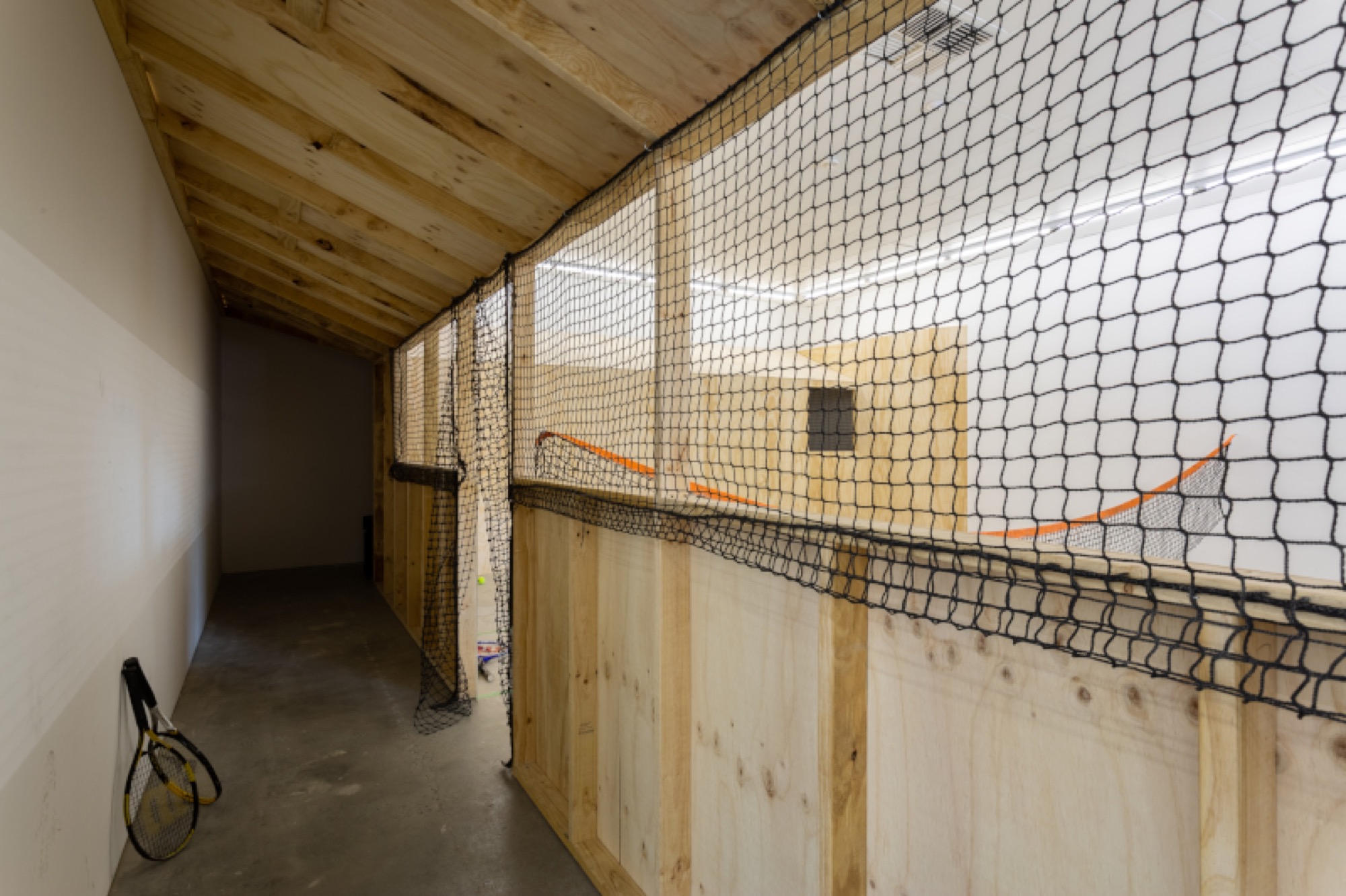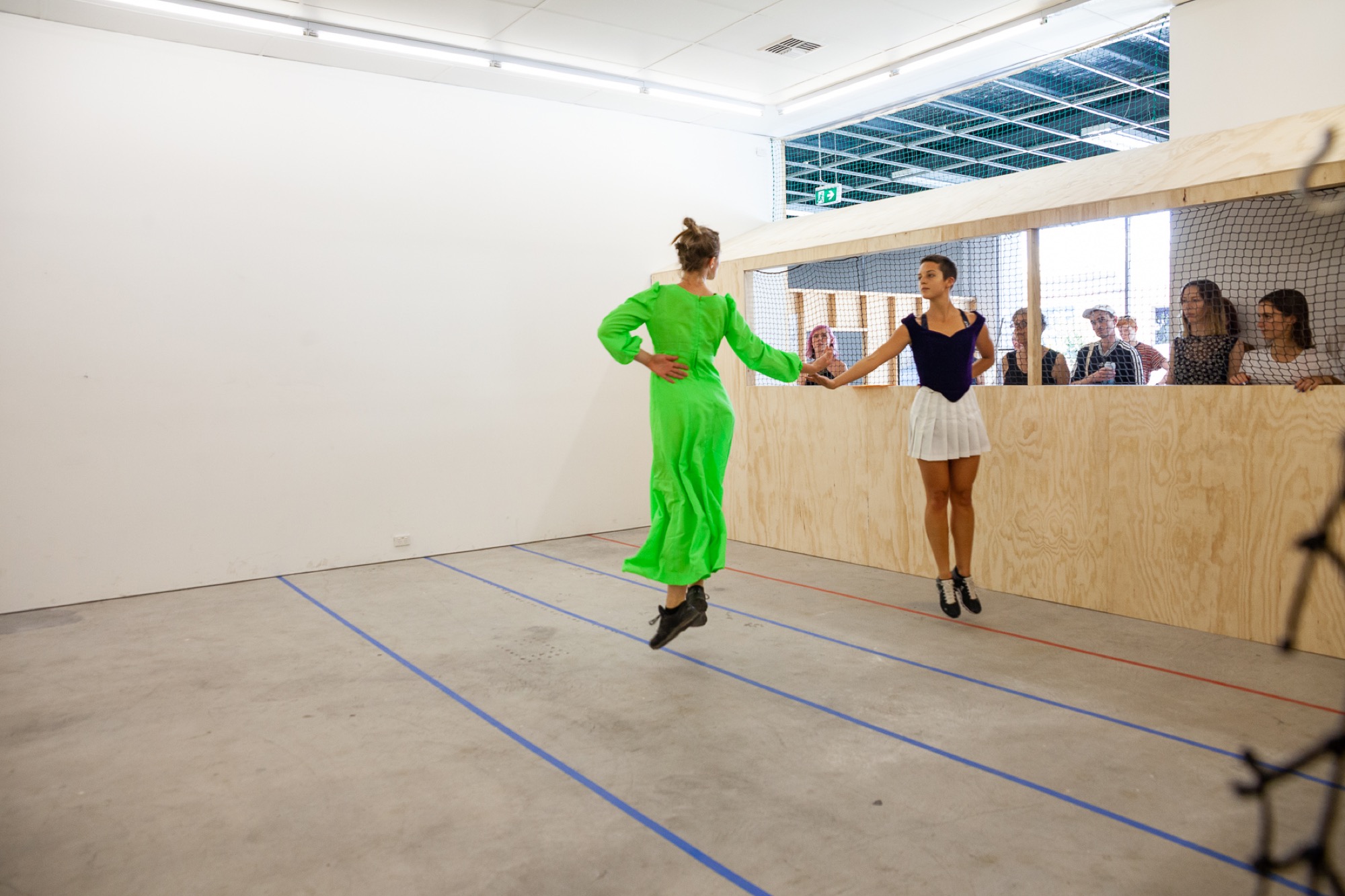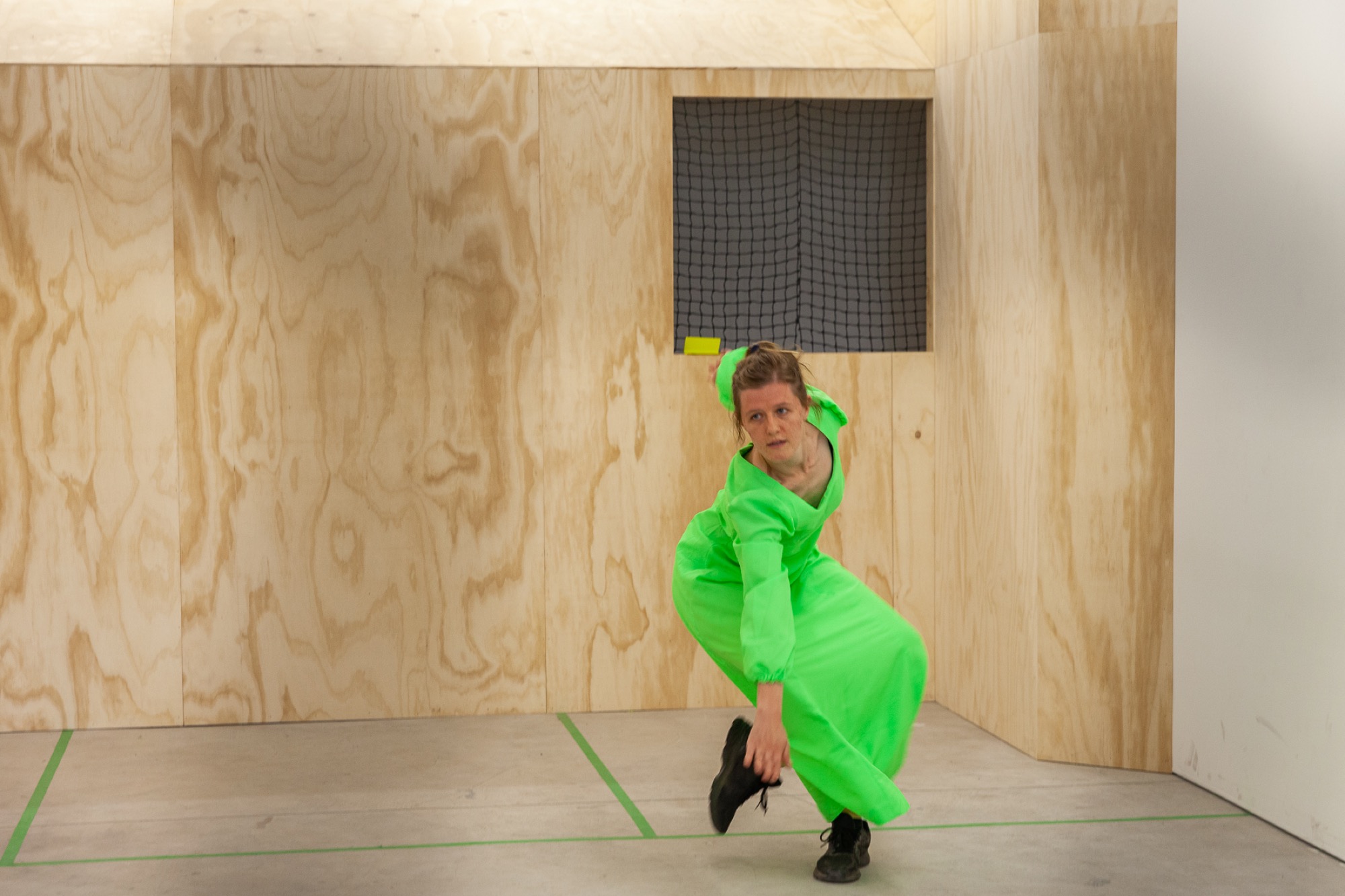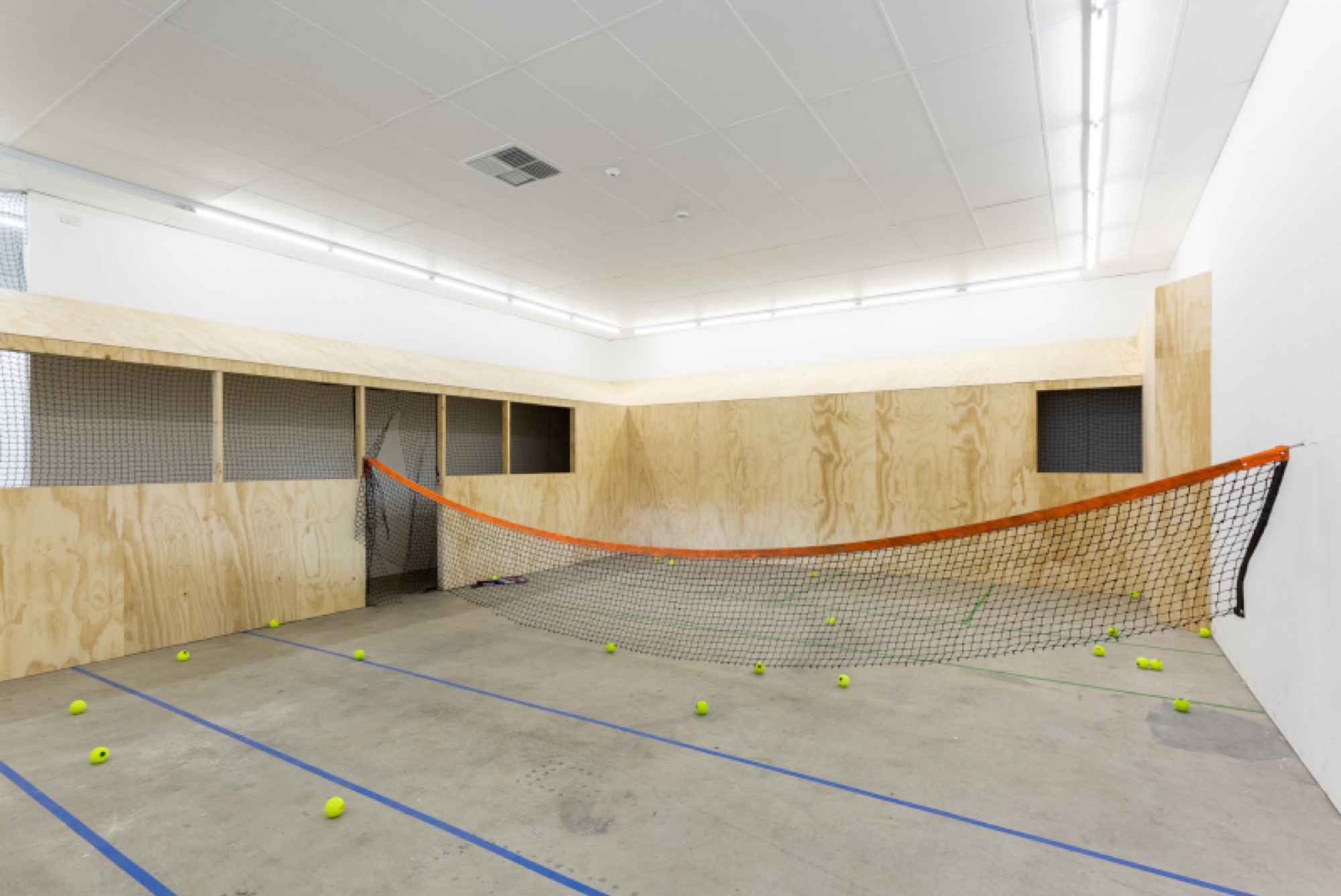Atlanta Eke, The Tennis Piece
Sophie Knezic
‘Oh my country! We will no longer have to go searching through the history of ancient peoples for worthy subjects on which to practise our brushwork…No, no people’s history offers me anything so great, so sublime as the Tennis Court Oath, which I am to paint.’ So opined the 18th century painter and revolutionary Jacques-Louis David, after securing the commission from the Société des Amis de la Constitution to paint the catalysing political episode.
The Tennis Court Oath is historically designated as precipitating the French Revolution: a gathering of the Third Estate in the Palace of Versailles, forced to convene impromptu in an indoor tennis court after being denied access to the official halls by the obstructionism of King Louis XVI, who declared themselves a National Assembly and collectively swore an oath to assemble as necessary in their pursuit of a new constitution. This audacious act—buoyed by the winds of political change—is retrospectively seen as instrumental to the instalment of the French Republic and the birth of democracy in France. David never completed his painting, but his sketch for the unfinished work, The Tennis Court Oath (1791) translates what we can only imagine as an urgent and clamorous convocation into a tightly choreographed, multi-figure composition redolent of a Neoclassical sublime.

Dancer and choreographer Atlanta Eke takes the Tennis Court Oath as a point of departure for The Tennis Piece: a two-part work comprising an exhibition at Gertrude Contemporary that preludes a subsequent dance performance programmed into Dance Massive 2019. The exhibition component presents a fabricated indoor tennis court, designed by Eke with her architect partner Tim Birnie, equipped with tennis balls and racquets, open to gallery visitors to enter and play. But the court becomes more charged when it intermittently turns into a stage for short performances by Eke and her co-dancers Annabelle Balharry, Ivey Wawn and Ellen Davies that function as ‘live trailers’ for the forthcoming performances at Dancehouse.

The Tennis Piece chimes with David’s antecedent in their mutual referencing of the import of the Tennis Court Oath and in their respective choreography of bodies, both presenting stylised figural arrangements that displace the customary physical exertions expected on a tennis court. In the short performances on the fabricated court at Gertrude Contemporary, the four dancers traverse the space in loose contrapuntal movements—weaving and looping with each other with joined hands in a manner that suggests the processional choreography of Renaissance dance. They form lines, take small, synchronised skips, diverge and re-join in a sequence of movements that eschew precision and appear calmly nonchalant. At times these intensify into more deliberate collisions, the dancers’ bodies forming pressed layers or separating to writhe on the ground while clutching one of the multiple tennis balls strewn over the court.
Occasionally, the dancers pick up racquets and pummel the yellow balls against the wall, reminding us that this is a tennis court after all. While Eke references the historic oath inaugurating democracy, she is just as interested in the actual game of real tennis. The adjective ‘real’ was appended to differentiate this version of tennis, formerly known as royal tennis, from a later derivation, ‘lawn tennis’. According to the first comprehensive history of the sport, The Annals of Tennis published in 1876 by Julian Marshall, tennis has a long lineage; it was played in Ancient Greece but became increasingly popular with royalty and the aristocracy over the 16th and 17th century. ‘These were the palmy days of Tennis’, Marshall declared, ‘the game was universal.’

The irony is that although tennis was the favoured game of kings, it did indeed become universal. Today, of course, it is played by millions of amateurs as well as by powerhouse athletes in the Grand Slams. But its fate turned in the 19th century, thanks to Major Walter Clompton Wingfield, an officer in the British Army, who patented a design for a simplified version of tennis named ‘The Major’s Game of Lawn Tennis’, which he sold commercially as a box set (including a net, racquets, rubber balls and court markers) in 1874, making the game instantly accessible to play. The necessary elements of real tennis—the specialised interior architecture of the tennis court with its sloping ceiling and viewing balconies, the game’s technically detailed rules of play, and the finely crafted balls and racquets—were dispensed with in one fell swoop.
Yet in the late 19th century real tennis—with its traditional wooden racquets and solid, hand-made cork balls—made a comeback and over the 20th century several exclusive clubs associated with WASP culture emerged, mostly in Britain. Currently there are 43 real tennis clubs in the world (including five in Australia), with some maintaining antiquated discriminatory policies such as the Racquet and Tennis Club on Park Avenue in New York, which still bans women from play.
As a child, Eke was surrounded by a culture of tennis; her father played the game professionally, making main draw appearances at the Australian Open and at Wimbledon, and together with Eke’s mother ran a tennis coaching business for 38 years. As a youngster Eke both played and coached the game. ‘By building a real tennis court at Gertrude’, Eke has stated, ‘we offer the court and the game for free to the public.’
Eke’s invitational emphasis finally links The Tennis Piece to another cultural form: the activated spectatorship or participatory practices of contemporary art; art that positions the viewer as a participant or co-producer and redefines the artist as a facilitator of social situations. However, as Claire Bishop points out in her now famous critique of Nicolas Bourriaud’s brand of relational aesthetics, socially engaged art can often lack a dimension of friction, instead effecting a kind of feel good community of immanent togetherness. For Bishop, works that produce social situations that generate a level of discomfort or unease—’a tougher, more disruptive approach to “relations”’—offer a more authentic model of participatory practice.

Bishop’s argument was consciously indebted to Chantal Mouffe and Ernesto Laclau’s theory of hegemony. All political orders, they argued, are expressions of hegemony and what appears as socially objective is in fact constituted by consolidated acts of power. Mouffe and Laclau’s thesis understood hegemony as formed through a necessary confrontation with antagonistic practices, with the concomitant that democracy perceived as the realisation of a harmonious social order elides the abrasive power relations constitutive of the political.
In later works, Mouffe developed the role of antagonism as inseparable from political social relations. Instead of pursuing a model of democracy based on consensus, achieved through rational representative rule, Mouffe argued for what she termed ‘agonistic pluralism’—a construction of democratic politics that does not eliminate antagonism but recognises it through the notion of the adversary. While antagonism is the brute struggle between enemies, agonism embodies the struggle between adversaries as conflicting but legitimate opponents. As Mouffe put it, ‘A well functioning democracy calls for a vibrant clash of democratic political positions.’
By positioning the work as pivoting on the original Tennis Court Oath, as well as a re-vamped tennis court that redresses the elitism of real tennis by inviting open participation from anyone, Eke summons a motif of emancipation and democratic access. The gentle twirls and skipping movements performed by the dancers also set a tone of decorum that tacitly reinscribes the site of the tennis court as a zone precipitating an ensemble of harmonious relations.
The catch, however, is that the game of tennis as it is professionally played is inherently and aggressively combative. The tennis court as a sparring field is in fact a genuine site of adversariness. Anyone who has seen a smash at the net, or an ace served powerfully down the line knows the raw, unadulterated duelling taking place at the highest level of athletic power. It is this sense of competitiveness, and the cut and thrust of extreme exertion, that seem curiously absent in Eke’s piece.

Eke is not the first contemporary artist to install a tennis court in pre-existing site; in 2017 Assad Reza’s Untitled (plot for a dialogue) presented a tennis court in a deconsecrated 16th- century church in Milan, furnished with balls and racquets as well as on-site coaches as a participatory space for visitors to enter and play. Footage of this event shows mild-mannered, somewhat tentative games of tennis being played, actions perhaps muted by the public’s awareness of the formerly hallowed nature of the site.
The raw energy of tennis that is eschewed in both Eke’s and Reza’s reconstructions is, by contrast, something that emerges in the world of literary fiction—exemplified by the late David Foster Wallace’s irrepressible passion for tennis and revealed in his ecstatic writings on the game. Most notably, Infinite Jest (1996), his sprawling parodic novel set in the fictional Enfield Tennis Academy, savagely anatomised the celebrity culture of budding tennis stars (known as étoiles) while leaving intact his adulation of the game. In shorter, journalistic pieces like ‘Roger Federer as Religious Experience’ (2006), Foster Wallace extolled tennis genius in palpitating language, alive to the game’s rituals and potent rivalry.
Ultimately, The Tennis Piece in its incarnation at Gertrude Contemporary presents the realm of tennis as equable and decorous—even bloodless—and a tennis court as a site that seems worlds away from either revolutionary fervour or primal competitiveness, or a paradigm of democracy understood as a field of agonistic relations. The gently propositional nature of the piece and the succinct moments of balanced choreography offer a model of civility that is even-tempered and composed. It is only when the dancers forcefully thwack the balls that something edgier threatens to break through to disturb the orderly tone, but doesn’t fully materialise—although perhaps this is the strategy of the kick serve with the ace yet to come.
Sophie Knezic is a Melbourne-based writer, academic and visual artist who works between practice and theory. She currently lectures in Critical and Theoretical Studies at the Victorian College of the Arts, The University of Melbourne and in History + Theory + Cultures at the School of Art, RMIT University.


